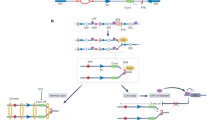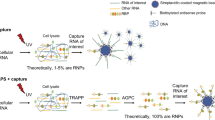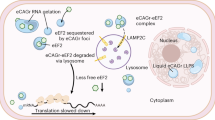Abstract
THE possibility of using gel electrophoresis for the fractionation of RNA was first well illustrated by Tsanev1, who obtained excellent separation of RNA main fractions, as well as minor components, by agar gel electrophoresis. More recently, Loening2 used the polyacrylamide gel electrophoresis recommended by Richards et al.3 and was able to obtain a very good separation of the two ribosomal fractions and transfer RNA in 2.2 per cent and 2.6 per cent gels and a separation of 4S and 5S RNA in 5 per cent and 7 per cent gels; this latter fractionation is not possible by agar gel electrophoresis.
This is a preview of subscription content, access via your institution
Access options
Subscribe to this journal
Receive 51 print issues and online access
$199.00 per year
only $3.90 per issue
Buy this article
- Purchase on SpringerLink
- Instant access to full article PDF
Prices may be subject to local taxes which are calculated during checkout
Similar content being viewed by others
References
Tsanev, R., Biochim. Biophys. Acta, 103, 374 (1965).
Loening, U. E., Biochem. J., 102, 251 (1967).
Richards, E. G., and Coll, J. A., Anal. Biochem., 12, 452 (1965).
Rosset, R., and Monier, R., Biochim. Biophys. Acta, 68, 653 (1963).
Author information
Authors and Affiliations
Rights and permissions
About this article
Cite this article
VENDRELY, R., ALEXANDROV, K., DE SOUSA LECHNER, M. et al. Fractionation of Ribonucleic Acids by ‘Sephadex’ Agarose Gel Electrophoresis. Nature 218, 293–294 (1968). https://doi.org/10.1038/218293a0
Received:
Revised:
Issue date:
DOI: https://doi.org/10.1038/218293a0
This article is cited by
-
RNA-sequencing exploration on SIR2 and SOD genes in Polyalthia longifolia leaf methanolic extracts (PLME) mediated anti-aging effects in Saccharomyces cerevisiae BY611 yeast cells
Biogerontology (2024)
-
Systematic comparison of RNA extraction techniques from frozen and fresh lung tissues: checkpoint towards gene expression studies
Diagnostic Pathology (2009)



